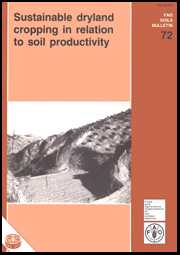
C.J. Pearson
The University of Queensland
Gatton, Australia
D.W. Norman
Kansas State University
Manhattan, Kansas, USA
J. Dixon
FARM Programme
FAO Regional Office for Asia and the Pacific
Bangkok, Thailand
FAO SOILS BULLETIN 72
|
Food and Agriculture Organization of the United Nations |
|
The designations employed and the presentation of material in this publication do not imply the expression of any opinion whatsoever on the part of the Food and Agriculture Organization of the United Nations concerning the legal status of any country, territory, city or area or of its authorities, or concerning the delimitation of its frontiers or boundaries. |
M-53
ISBN 92-5-103792-2
All rights reserved. No part of this publication may be reproduced, stored in a retrieval system, or transmitted in any form or by any means, electronic, mechanical, photocopying or otherwise, without the prior permission of the copyright owner. Applications for such permission, with a statement of the purpose and extent of the reproduction, should be addressed to the Director, Publications Division, Food and Agriculture Organization of the United Nations, Viale delle Terme di Caracalla, 00100 Rome, Italy.
© FAO 1995
This electronic document has been scanned using optical character recognition (OCR) software and careful manual recorrection. Even if the quality of digitalisation is high, the FAO declines all responsibility for any discrepancies that may exist between the present document and its original printed version.
Chapter 1 - Properties of dryland cropping systems
What is a cropping system?
Evolution of field crop ecosystems
Chapter 2 - Physical aspects of crop productivity
Interrelationships of soil resources and cropping systems
Soil pores and water characteristics
Soil fabric, density and strength
Soil structure and crop growth
How management directly affects soil structure
Field indicators of physical problems
Management for maintenance of soil physical properties
Chapter 3 - Biological and chemical aspects of soil productivity
Soil biology and the biological micro-environment
Organic matter
Soil organisms associated with the cropWeeds, crop pests and diseases
Inorganic nutrition
Field indicators of biological and nutritional problems
Management for maintenance of soil biology and nutrition
Chapter 4 - Sustainable crop rotations
Asian examples
Australian and mediterranean examples
Rotations and soil productivity
Chapter 5 - Summary of physical, biological and management aspects of dryland cropping
Lessons for dryland cropping systems
Need to import nutrients
Need for realistic pricing to encourage better crop and management choices
Participation by farmers and their responsibility for land care
Measurement of cropping sustainability
Desirability of matching biological solutions to local circumstances
Appropriate soil management and the use of fallows
Need for more legume crops
Weeds, pests and diseases as indicators of management expertise
Chapter 6 - Social and economic issues
Factors influencing farming systems
Households in the SATs
Communities in the SATs
Effects of support services and policies
Land
LabourCapital and cash
Cropping patterns
Interactions between crops and livestockStrategies to achieve sustainability
Background - Policies and institutions
Role of livestock
Productivity with sustainability
Agricultural productivity
Ecological sustainability
Need for a coordinated approach